Marine Behaviour – Identifying Scorpionfish
Marine Behaviour – Identifying Scorpionfish
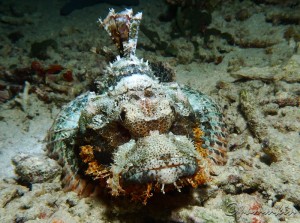
oxycephala) taken during a night dive in Menjangan Island, Bali
Found in the most conspicuous place on the reef, these masters of disguise and trickery assimilate into their surroundings complete with matching features. They either blend in or have bright warning colours that send signals to would-be-predators that they are poisonous and equally distasteful. Born with fins but they don’t really swim, these fish spring forward to ambush prey and move around by way of ‘crawling.’
In the search of this group of bizarre and awesome predators, I set out on a mission to document this elusive species of Scorpionfish, the world’s most venomous fish.

Knowing the reef helps especially in identifying objects that don’t belong. They lurk about on the rocks, crevices and reef tops. In some places in Indonesia, they lurk in volcanic sand, half buried. I told my buddy that we would be looking for toxic predators and he gave me a strange look. Having an objective prior to the dives will allow dive buddies to keep a lookout for your subject no matter how bleak it may seem.
Combing the reef without an objective might cause you to miss the nicely camouflaged Scorpionfish amongst the cluster of tunicate or sponges but having a trained vision for symmetrical shapes, picking out the unmistakable form will soon become second nature. The silently-still predator is armed and ready, with toxic spines, it became obvious for anyone to steer clear. Approaching it from the side or front allows the fish to accept your presence. They will dart if they don’t.

Hovering above or beside it without touching the reef is the art of suspension I’d learnt from not wearing a wetsuit nor gloves in the tropics. It forces me to regulate my breathing pattern and be still for the subjects I shoot. It gets harder to stay steady when my heart is palpitating with excitement as I frame the deadly fish on my screen.
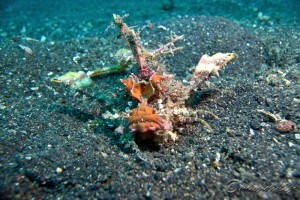
Straits, Sulawesi
Not all ‘beautiful’ and vibrantly coloured fish are pleasing to the eyes. There is a specie closer to the Stonefish family, that is monstrous-looking and the kind that would inspire Hollywood’s production of alien movies. It’s called the Devilfish (Inimicus didactylus), complete with dorsal javelins in place of fins; pelvic fins that evolved into a 2-pronged garden rake used for locomotion on the seabed and a skeletal face that looks so evil, you’d probably wonder it spawned an army to ambush you. If it wasn’t for its smallish size of 20 – 26cm, it would have been a harrowing experience seeing something so horrific and to imagine that such a creature would emerge from the sand midway in my dive. Found burrowed in sandy bottom, the Devil Scorpionfish is well camouflaged with only its eyes and mouth exposed on the sand’s surface. The dorsal spikes are tucked down as it lies completely still, in wait of a passing juicy morsel to pounce on. The inner pectoral fins are brightly coloured and though this specie may look mottled and knobbly, it is the Creator’s masterpiece.

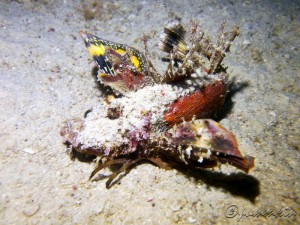
Island, Terengganu
Splashed with colours on its body, the patches of distinctive colours become the giveaway on the volcanic sands of Lembeh Straits in Northern Sulawesi, another destination I’ve chosen to document weird and bizarre creatures. Even the Lionfish and Leaf Fish are part of the Scorpionfish family. Closer to home, the Devilfish lies in wait in the sands of Tenggol Island and upon discovering its hiding place, it chose to walk away from the glaring video light of my camera setup! Watch video here:-
Splashed with mottled patches of colours on its body, the Devilfish would much rather have feet any day.
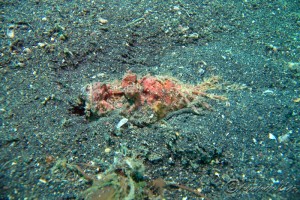
Very little is known about the dangers of the hidden monster but having pictures to caution other divers from putting their hands indiscriminately on the reef would help prevent a nasty wound or otherwise, have a holiday cut short for a trip to the emergency room.
Combing the reefs of Mabul, Tenggol, Bali and the sandy bottom in Lembeh Straits, you can capture these stunning and stunting fish. These pictures give you an idea of its surroundings and where they are usually found so
that you can set out to photograph them. Be wary where you put your hands on the reef because most often, Stonefish and Scorpionfish lurk in pairs. I discovered other toxic creatures along the way and have them caught on video to show you what people seldom see. Watch out for my next piece on octopi encounter!
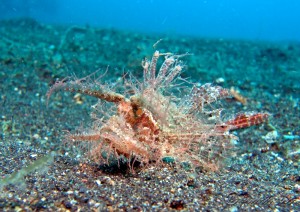
about 4cm in size
- Marine Behaviour – Identifying Scorpionfish – February 4, 2014
- A Woman – The Natural Photographer – January 9, 2014

 CAD
CAD
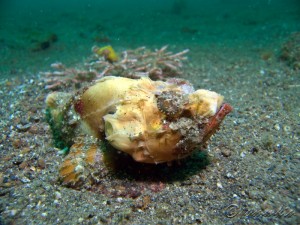
2 comments
Great article, Very informative. And fantastic pictures. Your pics will really help me to locate and identify more varieties on my next oceans encounter.
Thanks, Jimmy! It’s my pleasure to bring these treasures to you & I hope you will have as much fun finding them as I had!